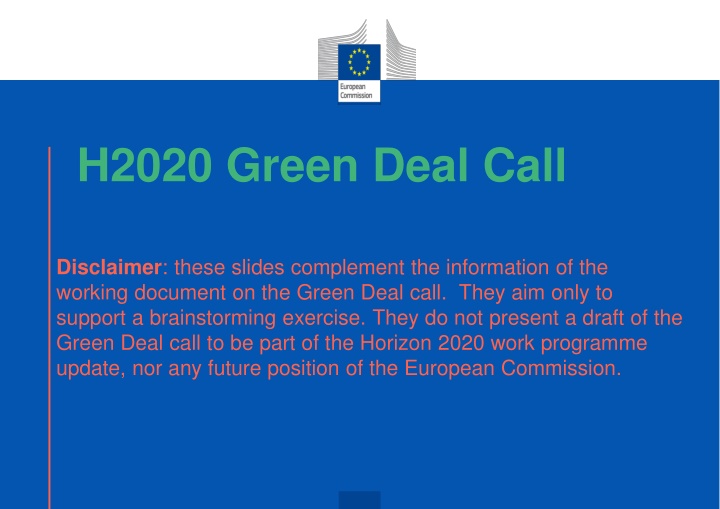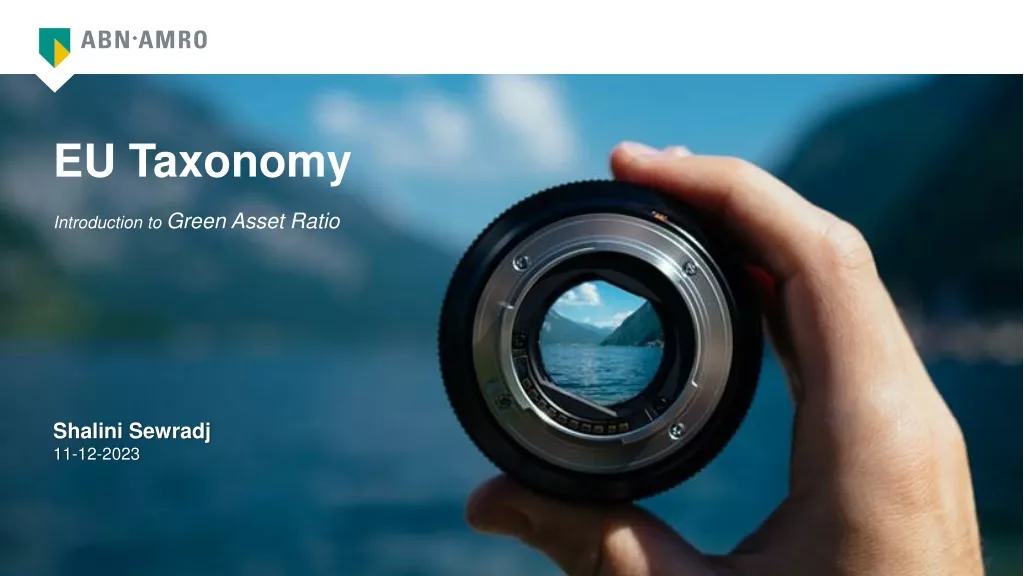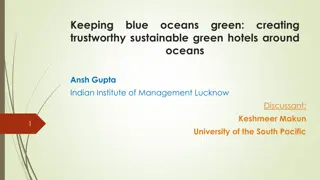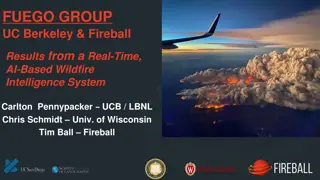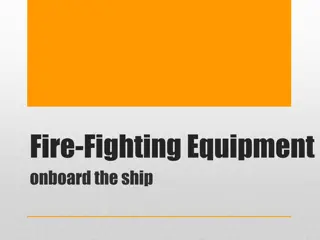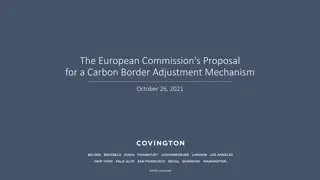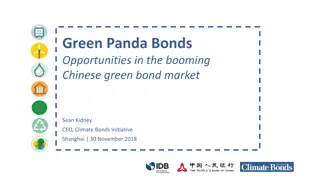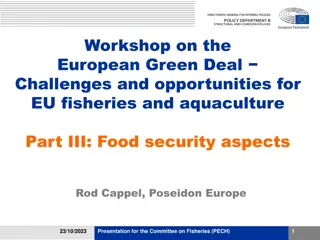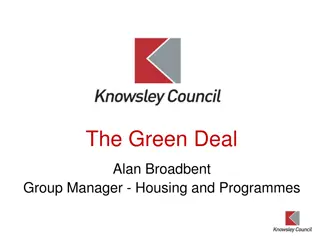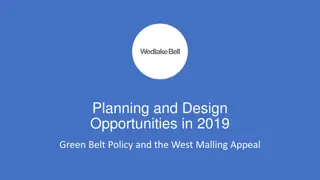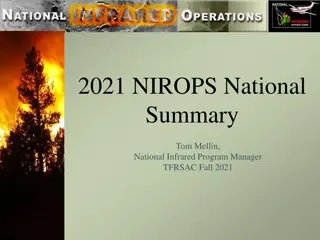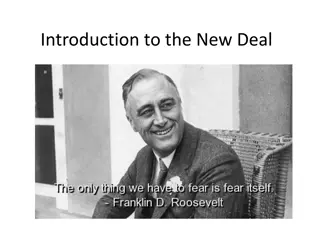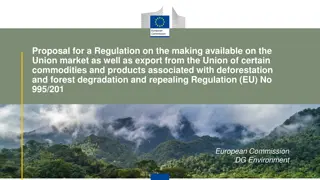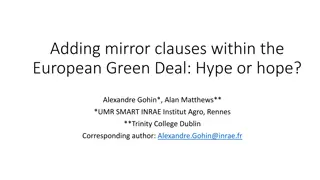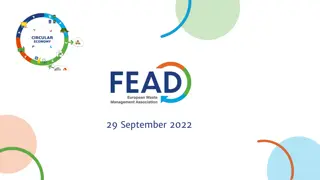European Green Deal Call: Preventing and Fighting Wildfires
Envisioned as part of the European Green Deal Call, the initiative focuses on researching, innovating, and demonstrating solutions to combat wildfires. With a goal to reduce wildfire impact, the plan aims to enhance prediction and management capabilities to mitigate environmental disasters. The efforts seek to minimize casualties, economic losses, and ecological damage caused by wildfires, proposing a strategic approach for prevention and response. The initiative emphasizes the urgent need to address the rising incidence of wildfires across different regions of the EU due to various factors including climate change, forestry practices, and demographic shifts.
Uploaded on Feb 25, 2025 | 1 Views
Download Presentation

Please find below an Image/Link to download the presentation.
The content on the website is provided AS IS for your information and personal use only. It may not be sold, licensed, or shared on other websites without obtaining consent from the author.If you encounter any issues during the download, it is possible that the publisher has removed the file from their server.
You are allowed to download the files provided on this website for personal or commercial use, subject to the condition that they are used lawfully. All files are the property of their respective owners.
The content on the website is provided AS IS for your information and personal use only. It may not be sold, licensed, or shared on other websites without obtaining consent from the author.
E N D
Presentation Transcript
H2020 Green Deal Call Disclaimer: these slides complement the information of the working document on the Green Deal call. They aim only to support a brainstorming exercise. They do not present a draft of the Green Deal call to be part of the Horizon 2020 work programme update, nor any future position of the European Commission.
The EuropeanGreen Deal Call Introductory remarks As a complement to the working document on the Green Deal call, we provide additional information in the form of slides. Please note that the information provided does not take account of the comments / contributions provided by the delegations to the overall working document on the Green Deal call. The next iteration in the development of the call will be based on first draft texts for the topics. Please bear in mind that this list of topics is only tentative, not binding and can be modified in the course of consultation with the member states and with external stakeholders.
The EuropeanGreen Deal Call MAIN PART OF THE CALL FOCUSSING ON INNOVATIVE SOLUTIONS AND DEMONSTRATIONS Area 1: Increasing Climate Ambition: Cross sectoral challenges Area 2: Clean, affordable and secure energy Area 3: Industry for a clean and circular economy Area 4: Energy and resource efficient buildings Area 8: Zero- pollution, toxic free environment Area 7: Ecosystems and Biodiversity Area 5: Sustainable and smart mobility Area 6: Farm to Fork Area 9: Strengthening our knowledge in support of the European Green Deal Area 10: Empowering citizens for the transition towards a climate neutral, sustainable Europe Area 11: International cooperation (tbc)
The EuropeanGreen Deal Call Area 1: Increasing Climate Ambition: Cross sectoral challenges
The EuropeanGreen Deal Call Preventing and Fighting Wildfires - Research & innovation, integration and demonstration - Green Deal s immediate priorities: reduce incidence and extent of forest fires and boost ability to predict and manage environmental disasters . Why? More EU citizens suffer directly & indirectly from wildfire impacts every year: hundreds of casualties, 2 billions economic damages and millions of ha of forest and Natura 2000 areas ravaged - not only in South but also rising in Central, East and North EU. Extreme wildfires as in Portugal (2017) and Greece (2018) will be more common, with negative effects on climate change (huge GHG), carbon sinks, biodiversity, air pollution. Climate change increases wildfires severity, extent of burned areas and length of the fire season in addition to unsustainable forestry, spatial planning and demographic changes. What to do?: Accelerate R&I, integrate, adapt & demonstrate holistic solutions ready to up-scale/deploy at local/regional/national/EU and international level. Targeted Impacts (by 2030 in EU): 0 casualties from wildfires. 50% reduction in accidental/arson ignitions 55% reduction in wildfires emissions (2030) 50% Natura 2000 areas fire-resilient Stimulation of new bioenergy value chains Improved health (citizens, firefighters) Fire suppression within 24 hours Net climate-neutral in 2050 90% losses from wildfires insured Prescribed fire management use
The EuropeanGreen Deal Call Preventing and Fighting Wildfires - Research & innovation, integration and demonstration - Proposed activities: Accelerate & demonstrate holistic solutions adapted to the new context of wildfires, integrating: Environmental, climate & socio-economic research, forecasting & strategy (eg biomass) Research, innovation & pre-deployment of better ground & aerial systems, techniques and capabilities (physical & digital) to prevent, predict, monitor, extinguish & recover. Proactive governance, large-scale & community-based risk assessments, education / training, preparedness & adaptation key: citizens, forest sector, first respondents. Tailor and demonstrate the integrated solutions on the field with end-users in pilot sites across Europe in different contexts (forest/bush/peat; wildland-urban interfaces/alpine/coastal; cross-border areas ) For up-scale/up-take e.g. in National climate change adaptation/disaster risk units, Union s Civil Protection Mechanism, Disaster Risk Management Knowledge Centre, Emergency Response Coordination Centre, European Forest Fire Information System, EU/regional/interregional initiatives, Copernicus Services, UN s Sendai Framework. Multilateral international cooperation can further leverage knowledge, resources, best practices and global impact e.g. with United States, Canada, Russia, Brazil and Australia.
The EuropeanGreen Deal Call Towards climate neutral and socially innovative cities What is at stake: Cities occupy 2% of the planet s landmass, consume over 65% of the world s energy and account for more than 70% of the global CO2 emissions Cities and local communities can benefit from social innovation and EU R&I towards the transition to climate neutrality, leaving no one behind 75% of the European citizens live in cities and possibly 80% by 2050: Cities will play a crucial role in reaching the targets of the Green Deal Objective of the topic: to support cities into using Green Deal-targeted social and technological innovation to co-create, test and implement holistic & integrated solutions with citizens and trigger changes in social practices and behaviour Targeted Impacts: Climate neutrality by 2030 of the participating cities (and districts) Empower cities and local communities through social innovation to cross social tipping points and make the Green Deal happen Mobilise the demand (citizens needs) to lead the transition to climate neutrality
The EuropeanGreen Deal Call Towards climate neutral and socially innovative cities Proposed activities: Support the development of climate action plans in cities (and local communities) Combine existing results of EU R&I with social innovation, and take advantage of the digital transformation to co-create and test solutions with local communities, including changes in social practices and behaviour Establish a one-stop shop in partner cities to help them implement their climate action plans Support twinning and mentoring on Green Deal objectives between cities from different countries and different sizes and creating a European ecosystem of social innovation hubs and local communities making the Green Deal happen Support large scale pilots of systemic solutions combining technological, social, cultural, regulatory and/or financial aspects, inspired by good practices available at local, national and/or European level
The EuropeanGreen Deal Call Demonstrating innovative solutions for resilience of regions to climate change Every half-degree of global warming may inflict a new order of magnitude of harmful consequences on planetary health, economic and social cohesion. We need radical and transformative ways of building resilience to climate variability and change. Scaling up and demonstrating systemic, integrated solutions and technologies at a large scale is the way forward to trigger behavioral changes. Solutions that combine technological, business, governance, environmental contribute to the development of adaptation pathways tailored to the most vulnerable regions and communities to climate change. and social innovation will Targeted Impacts: Accelerate transformative change across all regions and sectors of society Massive increase of community resilience and capacities to cope with unavoidable effects of climate change Specific EU Green Deal targets: EU Adaptation Strategy EU Forest Strategy Farm to Fork Strategy
The EuropeanGreen Deal Call Demonstrating innovative solutions for resilience of regions to climate change Proposed activities: Development of region-specific portfolios of solutions for climate action may include: increase water efficiency in regions and enhanced planning for floods and droughts; adapt to temperature increase with sustainable cooling solutions that decrease energy demand and reduce fatalities during heatwaves nature-based adaptation solutions for coastal defence infrastructures insurance innovations that incorporate a dynamic, long-term, and adaptive view of climate risk into modelling and pricing support to the development of coherent policy frameworks at regional level that give priority to the implementation of urgent and no-regret adaptation actions
The EuropeanGreen Deal Call Area 2: Clean, affordable and secure energy
The EuropeanGreen Deal Call Demonstration of innovative critical technologies to enable future large- scale deployment of offshore renewable energy technologies and their integration into the energy system. To decarbonise Europe, clean renewable power production must become the main source of energy. A Clean planet for all, provides estimates for the offshore wind capacity in Europe of 240-440 GW by 2050. This increase would represent a paradigm shift in the European energy system and require a modern infrastructure to transport offshore renewable energy power to onshore, including through the option of power-to-X. This buildout needs to be attained while also protecting the environment and biodiversity and securing a just transition, all while ensuring cost-efficiency. There is a need for more efficient and cost-effective technologies using wind, wave and/or tidal resources, considering the potential of the different European sea basins. Targeted Impacts: To accelerate the development of innovative critical offshore technologies for the realization of a clean renewable power production system needed to transform the EU into a fair and prosperous society, with a modern, resource-efficient and competitive economy where there are no net emissions of greenhouse gases in 2050. To accelerate the future roll-out of large-scale deployment of offshore renewable energy, considering market perspective and social, environmental and economic impacts. To increase incentives for investment and economies of scale in offshore bringing down costs and it will create new business models and services
The EuropeanGreen Deal Call Demonstration of innovative critical technologies to enable future large-scale deployment of offshore renewable energy technologies and their integration into the energy system. Proposed activities: Demonstration of critical offshore renewable energy innovations at sea considering the efficiency, reliability and sustainability that is needed in all areas of the offshore renewable energy system notably: -Offshore renewable energy power generating systems: innovative large scale integrated systems, floaters and substructures, mooring and anchoring systems specifically conceived for floating offshore considering the varied subsea conditions for floating offshore systems. -Grid infrastructure: demonstration of innovative High Voltage Direct Current (HVDC) technologies and systems (like multi-vendor Multi Terminal HVDC (MT HVDC) systems, grid forming converter, and DC circuit Breaker); technologies innovative dynamic inter-device/inter-array cables and connections to converter stations at sea or offshore hubs have to be considered. -Power to X /storage systems: innovative storage and/or green power to X (including hydrogen) systems to maximise the use of offshore resources. It shall address at least the offshore renewable energy power generating systems and the related energy system integration requirements, and may address grid infrastructure and/or power to X/storage systems. Proposals shall address marine spatial planning (making multi-use of the seas possible), industrial design and manufacturing processes, installation methods, transport and operation & maintenance and supply chains. for floating renewable energy
The EuropeanGreen Deal Call Develop and demonstrate a 100 MW electrolyser upscaling the link between renewables and industrial applications Demonstrate energy system integration through hydrogen: produce hydrogen from RES and use it in a commercial/industrial application (e.g. chemical or petrochemical industry) Targeted Impacts Impact 1: Establish a European industry capable of developing a novel 100MW electrolyser using a European value chain Impact 2: Increase the efficiency of the electrolyser reaching an energy consumption of 49 (ALK) to 52 (PEM) kWh/kg H2 at nominal power Impact 3: Increase the current density to 1A/cm2 (ALK) or 3A/cm2 (PEM) and delivery pressure to 30 bar Impact 4: Reduce the plant s footprint by 30% thanks to the larger modules and the plant layout as well as the higher current densities Impact 5: Reduce the electrolyser CAPEX by 20% down to 480/kW and 700/kW for Alkaline and PEM electrolysers respectively
The EuropeanGreen Deal Call Develop and demonstrate a 100 MW electrolyser upscaling the link between renewables and industrial applications Proposed activities: 1. Develop modules of 4-5 MW (or larger) with reduced balance of plant, managing efficiently the input power, the output hydrogen streams and the heat flows, while ensuring the reliability of the system and reducing the footprint Assemble the modules into a 100MW electrolyser system Test and demonstrate the 100MW electrolyser in real life conditions, operating flexibly to harvest maximum renewable power and provide grid- balancing services, and supplying renewable hydrogen to a commercial/industrial application Assess the performance and the durability of the electrolyser operating dynamically Address potential safety issues 2. 3. 4. 5.
The EuropeanGreen Deal Call Area 3: Industry for a clean and circular economy
The EuropeanGreen Deal Call Closing the carbon cycle in industry: renewable energy driven reduction of CO2using innovative catalytic materials and technologies Energy intensive industries, such as steel, chemicals and cement are key to Europe s economy, but they account for 20% of the EU s greenhouse gas emissions. R&I is proposed on innovative catalytic materials and technologies using renewable energy driven conversion of CO2emissions into fuels, polymers and chemicals. Targeted Impacts: Impact 1 - Demonstrate technical and economic viability of renewable energy driven conversion of CO2as feedstock, at pilot plant level, to produce climate- neutral fuels, polymers and chemicals. Impact 2 Affordable and efficient production, storage and distribution of renewable energy carriers. Impact 3 - Significant reduction of industrial CO2emissions (~200 Mt p.a. by 2050). Impact 4 - Improvement of air quality by reducing the direct flue gas emissions. Impact 5 - Contribution to industrial circularity and to meet the GHG emissions reduction target for 2030 and climate neutrality by 2050.
The EuropeanGreen Deal Call Closing the carbon cycle in industry: renewable energy driven reduction of CO2using innovative catalytic materials and technologies Proposed activities: Develop and deploy highly innovative catalytic materials and renewable energy driven technologies for the production of synthetic fuels, polymers and chemicals from industrial waste gas emissions (CO2and CO streams) with a 50% increase in the overall efficiency compared to the state-of-the-art at a sufficiently large scale with a demonstrated cost effectiveness with a demonstrated exploitability of the developed technology through the full value chain
The EuropeanGreen Deal Call Demonstration of systemic solutions for the territorial deployment of the circular economy Build sustainable, regenerative and just circular economy to reconcile with the limits and boundaries of our planet; focus on local and regional levels as suitable for closing material loops and creating sustainable circular ecosystems; demonstrate concrete systemic solutions for the territorial deployment of the circular economy in at least three territorial clusters in Europe; facilitate their replication. Targeted Impacts: Demonstrate R&I systemic solutions for the territorial deployment of the circular economy at the level of governance closest to citizens: increase the clusters overall resource efficiency and reduce GHG emissions; increase circularity in clusters key economic sectors; create jobs and new business opportunities. Replication: lay the foundation for systemic solutions for the territorial deployment of circular economy in other areas; multiply the territorial economic, social and environmental benefits provided by each cluster to achieve policy targets at national and European level.
The EuropeanGreen Deal Call Demonstration of systemic solutions for the territorial deployment of the circular economy Proposed activities: engage, train, support, coordinate and facilitate the cooperation between key actors constituting each cluster: administrations, industry (including SMEs), scientific community and civil society; develop and demonstrate science, technology, governance, economic, social and environmental solutions to increase the circularity in key economic sectors such as waste, water, food, feed, wood, terrestrial and aquatic bio-based value chains, textile, plastics, electrical and electronic equipment, construction and buildings; ensure the exchange of relevant information and experiences within and across clusters and also with other actors not involved in the proposals. Criteria: sustainability, inclusiveness, and social justice at the heart of each systemic solution; replicability potential of each solution is essential; totality of the territorial clusters should reflect a geographical spread within Europe and should be of different sizes and socio-economic structures; TRL 7-8 at the end of the project.
The EuropeanGreen Deal Call Area 4: Energy and resource efficient buildings
The EuropeanGreen Deal Call Building and renovating in an energy and resource efficient way To design and construct new or retrofit existing buildings as zero-emission/zero- pollution, positive energy powerhouses. The multiplication of such buildings in green neighborhood living labs with additional urban functionalities (e.g. shared EV charging facilities) will enable the market and consumer uptake potential of the innovations. Targeted Impacts: To accelerate the diffusion of the high efficiency zero-emission/zero-pollution, sustainable technologies and innovations needed for the full decarbonisation of the building sector. This will increase incentives for investment and economies of scale bringing down costs for all and it will create new business models and services, new usages, changed behavior. To enable an energy transition corresponding to a just transition in the building sector, ensuring a healthy and safe living environment while supporting an increase of renovation rates. Most importantly, leading to highly energy and resource efficient, cheaper to run green neighborhoods a crucial advantage for the least well-off who can not afford to live in an energy inefficient way.
The EuropeanGreen Deal Call Proposed activities: Scalability design of positive energy neighborhoods well embedded in the spatial, economic, technical, environmental and social context of the sites High energy efficiency building designs (incorporating thermal design and orientation), adapted to local environments; highly efficient building operation. Innovative and more energy efficient integrated renewable electricity technologies in the buildings and urban service facilities. Innovative and sustainable highly energy and cost efficient RES heating and cooling solutions. Energy storage systems (e.g. using second life batteries from electric vehicles) without limiting the use of living space (e.g. neighbourhood optimized storage). Digital technologies for system monitoring at neighbourhood scale, as well as digital solutions to increase energy efficiency of building systems and appliances operation. Education and training for sustainability, conducive to competences and positive behaviour/good habits for a resource efficient and environmentally respectful energy use. Accelerating innovation spread through involvement of the whole buildings value chain and coordination on standards and regulatory aspects for efficiency of buildings and heating and cooling technologies.
The EuropeanGreen Deal Call Area 5: Sustainable and smart mobility
The EuropeanGreen Deal Call Green Airports and Ports: green aviation and shipping Large-scale, real-life demonstrations of green airports, maritime and inland ports Targeted Impacts: Accelerated deployment of sustainable alternative fuels (including advanced biofuels, hydrogen, ammonia), electromobility, energy storage and waste heat recovery in ports and airports On-site clean energy / fuel production and distribution (particularly green hydrogen and electricity) and increased alternative (bio-) fuel supply, on site electricity generation with refueling and re-charging capabilities Zero-emission ports and airport operations by 2030 Reduced waterborne and aviation transport emissions and improved air quality at ports and near airports Energy-efficient port and airport operations and buildings, green logistics, integration with other low-emission transport modes Reduced emissions for cities and improved city integration for ports and airports
The EuropeanGreen Deal Call Green Airports and Ports: green aviation and shipping Proposed activities: Pilot/demo plants of zero-emission energy production and supply at ports and airports (electricity, hydrogen, sustainable alternative fuels) On-shore supply systems, storage, distribution and power/re-charging/alternative re-fuelling infrastructure for aircrafts and ships Large-scale, real-life high TRL demonstrations of green maritime and inland ports, of different sizes, across 3 airport dimensions: transport; energy supply; terminals Integration with operations and green logistics, innovative construction, dredging, infrastructures, effective and green land use New tools and optimisation mechanisms for multimodal access, passenger and freight flows into / out of ports and airports, facilitating access and reducing traffic from / to the city Non-technological framework conditions, new multi-actor governance and investment analyses
The EuropeanGreen Deal Call Area 6: Farm-to-Fork
The EuropeanGreen Deal Call Farm-to-Fork Full title : From farm to fork: testing and demonstrating high impact innovations to address food system challenges in a place-based context. An Innovation Action (IA), that calls for demonstration projects to test, pilot and showcase place-based, innovative system solutions to 4 pressing food systems challenges, and resulting in 4 targeted impacts: 1) (a) achieving climate neutral farms, and/or b) achieving climate neutral food businesses; 2) reduction of pesticides, antimicrobials, fertilizers and harmful nutrients, towards zero pollution 3) reduction of food loss and waste 4) shifting to sustainable and healthy diets, sourced from land and sea.
The EuropeanGreen Deal Call Farm-to-Fork Projects will: 1) maximise synergies and minimise trade-offs between the three dimensions of sustainability (social/health, climate/environmental and economic) & respect planetary boundaries. 2) address one of the 4 challenges & integrate the following elements: Systemic approach at the basis of a plan to tackle the challenge: from identifying drivers and root causes of systemic challenge to assessing impact of solutions Multi-actor approach, engaging partners to co-create, test and demonstrate solutions Most appropriate mix of innovations: technologies, business models, governance models, and social innovations, taking into account the place- based context An action plan for communication and engagement, in and beyond the regions where the activities take place
The EuropeanGreen Deal Call Area 7: Ecosystems and Biodiversity
The EuropeanGreen Deal Call Restoring biodiversity and ecosystem services Test, demonstrate and promote systemic solutions for up-scaling the restoration of biodiversity and ecosystem services Targeted Impacts: Tested up-scaling of large-scale and urgent restoration actions on the ground, to prepare resilient ecosystems and their services at sea and on land Restoration actions are implemented which will enhance natural carbon sinks and reduce the effects of emissions, locally reverse biodiversity decline and improve the delivery of a range of ecosystem services (in the short- to long-term) Nature-based solutions are adapted, integrated and demonstrated in governance, financing, public procurement, economic development, infrastructure and regional strategic landscapes Demonstration of how restoration activities enable sustainable, climate-smart, inclusive, transformative approaches Value created for communities affected by transformative change through the restoration of their degraded terrestrial and marine environment Showcase how massive restoration can help enabling transformative change including of social and behavioural factors, which will be beneficial for biodiversity
The EuropeanGreen Deal Call Restoring biodiversity and ecosystem services Proposed activities: Restore degraded ecosystems at sea and on land at large scale Test innovative methods for upscaling restoration Replicate deployment of restoration towards resilient ecosystems and their services at regional, national and cross-border levels Address barriers to the implementation of nature-based solutions Showcase in practice how to maximize synergies and avoid trade-offs between priorities for restoring biodiversity, mitigating and adapting to climate change Support the development of specific demand and supply chains in restoring ecosystems Work for communities in transition affected by transformative change through the restoration of their degraded terrestrial and marine environment Developing answers on how to frame transformational change, which supports a just transition by investing in nature, to explicitly help vulnerable regions and communities to improve their resilience when rapid changes in climate and environment, economies and social conditions occur. Generate knowledge on how enabling transformative change can be beneficial for biodiversity and climate change, and bring this information into IPBES and IPCC processes
The EuropeanGreen Deal Call Area 8: Zero-pollution, toxic free environment
The EuropeanGreen Deal Call Mitigating the effects of persistent and mobile chemicals The Zero Pollution Ambition for a Toxic-free Environment calls for rapidly addressing the risks posed by very persistent chemicals. This call topic aims at demonstrating innovative solutions to protect health, environment and natural resources from persistent and mobile chemicals, such as PFAS, a group of thousands of manmade chemicals that are widely used in various consumer and industrial products, to which citizens are exposed. Targeted Impacts: Better understanding of a persistent pollution problem of human and environmental health relevance Better remediation and detection technologies Data for risk assessment, made accessible to policy making and risk communication
The EuropeanGreen Deal Call Mitigating the effects of persistent and mobile chemicals Proposed activities: Research and development of remediation technologies of contaminated soil and water for persistent and mobile substances; New methods to measure persistent and mobile chemicals in different media; Develop and carry out environmental and human (bio)monitoring of persistent and mobile substances; Gather toxicity and toxico-kinetic information in order to allow characterising all risks to human health; Develop best practices for the management of waste containing persistent and mobile substances
The EuropeanGreen Deal Call Towards innovative regulation of chemical and pharmaceutical mixtures The new Chemicals Strategy for Sustainability, proposed under the EGD, calls for the regulatory framework to rapidly act on the risks (underestimated) posed by combination effects of different chemicals to better protect both citizens and the environment against hazardous substances. This call topic aims at demonstration studies to show how innovative solutions can be applied in risk assessment to identify, prevent and manage harmful co- exposures to industrial chemicals and pharmaceuticals. Targeted Impacts: Identification of most commonly encountered mixtures, their impacts on different parts of the ecosystem and human health, and implementation of solutions to reduce the most critical exposures; More targeted and innovative risk assessment of mixtures of chemicals and pharmaceuticals to better assess their presence in drinking water, soil, food and feed.
The EuropeanGreen Deal Call Towards innovative regulation of chemical and pharmaceutical mixtures Proposed activities: Demonstration of innovative solutions to quantify and prevent the most harmful co-exposures to industrial chemicals and pharmaceuticals. Advanced solutions for the establishment of causality between co-exposures and effects Development of targeted and non-targeted high-throughput technologies for screening, and advanced bioinformatics approaches, such as artificial intelligence and other data mining methodologies, to identify the most representative real-life mixture scenarios in humans Identification of lead components in mixtures, responsible for the impact on human health and the ecosystems
The EuropeanGreen Deal Call Area 9: Strengthening our knowledge in support of the European Green Deal
The EuropeanGreen Deal Call European Research Infrastructures capacities and services to address European Green Deal challenges Mobilisation and advancement of world-class capacities and resources such as those offered by European Research Infrastructures (RIs) for energy storage and climate/environment observation. Targeted Impacts: Enabling breakthrough research and innovation in energy storage across the whole value chain and with a life-cycle approach Anchoring European RIs in an efficient and competitive research and industrial ecosystem for energy storage Strengthening the observation and monitoring of GHG emissions, ultrafine particles and air quality, in particular in and around urban areas Providing evidence for the development of sustainability strategies, taking also account of impacts on health Advanced, optimised and harmonised research services and data to address Green Deal objectives New advanced skills to exploit the most advanced instruments and resources for R&I addressing Green Deal challenges
The EuropeanGreen Deal Call European Research Infrastructures capacities and services to address European Green Deal challenges Proposed activities: The activities will focus on: transnational and virtual access to advanced R&I infrastructures, including users training and scientific and technical support and data analysis to accelerate the transition toward a decarbonised energy/transport EU system provision of integrated and customised services and innovative solutions for the observation and monitoring of GHG emissions, ultrafine particles and air quality, in particular in and around urban areas: interoperable data, tools/equipment and models for the scientific community and public authorities/decision makers development of synergies between research infrastructures and relevant local, European and global initiatives in different disciplinary areas, including health and social sciences
The EuropeanGreen Deal Call Developing end-user products and services for all stakeholders and citizens, supporting climate adaptation and mitigation Provide more detailed information in space and time, relevant to real-world decision-makers to identify which modes of production, consumption and lifestyle are compatible with climate resilience and pathways achieving climate neutrality by 2050. Targeted Impacts: Improved delivery of climate service delivery in the last mile of the value chain, across the priority sectors of the European Green Deal Increased accessibility of information on climate effects to citizens Improved quality of data and information on climate adaptation and mitigation Well characterised social and behavioural factors necessary for the climate transition Improved climate adaptation and mitigation solutions enabling overcoming societal and economic barriers Better informed citizens and stakeholders on options for climate action in their own communities, regions and sectors More opportunity for stakeholders to test adaptation/mitigation solutions on the ground.
The EuropeanGreen Deal Call Developing end-user products and services for all stakeholders and citizens, supporting climate adaptation and mitigation Proposed activities: Advancing climate science and models, and downscaling their findings to improve their user relevance Delivering the next-generation of climate services for end users (building on GEOSS and Copernicus services, in collaboration with ESA). Testing these services on demonstrations sites with the provision of guidance services. Making the above findings accessible to the public, going beyond existing tools in both scientific robustness and user relevance. Synthesising this knowledge by bridging the gap between the expert tools already generated by European science, and the stakeholders who are making decisions today that will both affect and be affected by climate change and its impacts. Converting the mitigation pathways that are compatible with our climate goals into clear information on how production, consumption, infrastructure and lifestyle need to change.
The EuropeanGreen Deal Call Towards a transparent & accessible ocean (a Digital Twin Towards a transparent & accessible ocean (a Digital Twin of the Ocean) of the Ocean) This topic supports the development of an EU integrated digital ocean, building on existing Copernicus, EMODNET, ERICs assets, addressing concrete cases in local or regional sea basins, and demonstrating their usefulness with regard to several of the Green Deal priorities Targeted Impacts: Societal awareness and greater private and citizen engagement promoting co- creation of solutions with Member States Increased purposeful observation and modelling capacity and data sharing Higher integration of existing EU assets (data, techs, infras) Fact-based decision-making and implementation of legal requirements, Shared responsibility (gov, industry, citizens) to monitor and ensure sustainable marine economic activities and exploitation of ecosystem services (fishing, aquaculture, transport, offshore energy, ) Allow assessments of ecosystems and habitats and development of biodiversity conservation strategies Achievements of Green Deal objectives with the help of digital tools in coastal areas and over ocean
The EuropeanGreen Deal Call Towards a transparent & accessible ocean (a Digital Twin of the Ocean) Proposed activities: digital interactive replicas of the oceans and seas Build on the integration of existing EU leading-edge capacities in ocean observation, forecasting and data warehousing with innovative IT technology Concrete cases in local or regional sea basins, demonstrating the use of digital twins with regard to several of the Green Deal priorities, integrated into national infrastructures Concrete cases: infrastructure vulnerability, development of mitigation, adaptation and replacement plans to deal with climate risks, optimisation of emergency responses to severe events, sustainable fishing, aquaculture, transport, offshore energy, Continuous, timely, transparent monitoring Identification and digital testing of possible solutions, what-if scenarios cover the whole knowledge value chain: sensors, modelling, big data and AI applications, user-based services
The EuropeanGreen Deal Call Area 10: Empowering citizens for the transition towards a climate neutral, sustainable Europe
The EuropeanGreen Deal Call European capacities for citizen deliberation and behavioral change for the Green Deal This topic covers two sub-areas: citizen deliberation and behavioural change with one project expected to be funded in each area. Targeted Impacts: Ownership and engagement from people across Europe through citizen deliberation Behaviour change at both individual and collective levels through behavioural research Structured expertise, research and practice networks of the highest ethical and methodological standards across Europe on the above.
The EuropeanGreen Deal Call European capacities for citizen deliberation and behavioral change for the Green Deal Proposed activities: Projects retained will: Establish transnational networks of experts, researchers and practitioners Implement deliberation processes and behavioural research on priority issues to deliver on the Green Deal Ensure balanced overall coverage of EU and associated countries, associating national/local governments and administrations Establish independent boards of guarantors to ensure scientific soundness, ethical and unbiased character of these activities.
The EuropeanGreen Deal Call Empowering citizens to act on climate change through education, monitoring of their environmental impacts, and civic involvement The aim of this call topic is to empower and directly involve citizens in realising their personal impact on climate and the environment thus leading to a change in their behaviour, reducing their personal carbon footprint and taking action at societal level towards a more sustainable future. Targeted Impacts: Improved citizens engagement in addressing climate change and other human-induced actions harming the environment Strengthened climate issue awareness of new generation through education Accelerated change of citizen s behavior towards more sustainable patterns. Increased citizens empowerment in monitoring climate parameters through sharing the wealth of data they collect with their wearables
The EuropeanGreen Deal Call Empowering citizens to act on climate change through education, monitoring of their environmental impacts, and civic involvement Proposed activities: Establish a competence framework on climate change and Green Deal implementation, which will serve as a reference tool for the MS, stakeholders, and NGOs to empower citizens to become engaged actors in the Green Deal. Concrete implementation of this framework will be encouraged on demonstration sites (e.g. in schools, universities and identified education communities). Engage citizens and education systems on climate-related issues, biodiversity, marine pollution and sustainable food through e.g. the European Ocean Literacy platform, the European Atlas of the Seas, citizen science, civic consortia, deliberative democracy initiatives, businesses, NGOs and municipalities Collect environmental data through individual devices (personal wearable sensors, app registering consumer behavior on carbon footprint, extreme weather community app, marine litter watch, etc.) Involve citizens in realizing their own environmental impact and empower them with concrete advice for behavioral change
The EuropeanGreen Deal Call Area 11: International cooperation (tbc)
